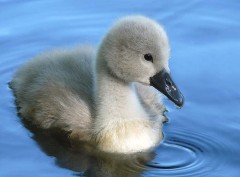
A baby swan is called a cygnet.
Swans are part of the family of birds known as Anatidae. This family of birds also includes geese and ducks. The swan is the largest bird in the family.
There are seven species of swan and the average number of eggs in each clutch is six. The average swan egg can weigh up to 34 grams and the incubation period is normally between 33 and 45 days.
The largest of the swan species, the whooper swan, can reach lengths of 60 inches and can weigh up to 33 pounds. Swans have larger necks and feet than geese and their wingspan can reach up to 10 feet. The male swan is normally larger and heavier than the female of the species. The swan is the only bird to have teeth.
The teeth are actually small and jagged and are attached to the beak. They are used to assist in the catching and eating of fish. Swans are generally herbivorous, although they do eat a small number of fish. The swan feeds both in the water and on land and they are one of the only animals to be monogamous.
The male and female swans tend to stay together as a bonded unit for life. Five species of swan are native to the Northern Hemisphere, one is found in Australia and New Zealand, and the other species is found in South America. There are no swans that are native to Asia, Central America or Africa. The Mute swan has been introduced to North America.
It is a well-tempered bird, but if they feel that their nest is being threatened they will attack. They have been known to attack humans, foxes and other birds. The Mute swan will also attack boats that they see as a threat to their nests and their young.